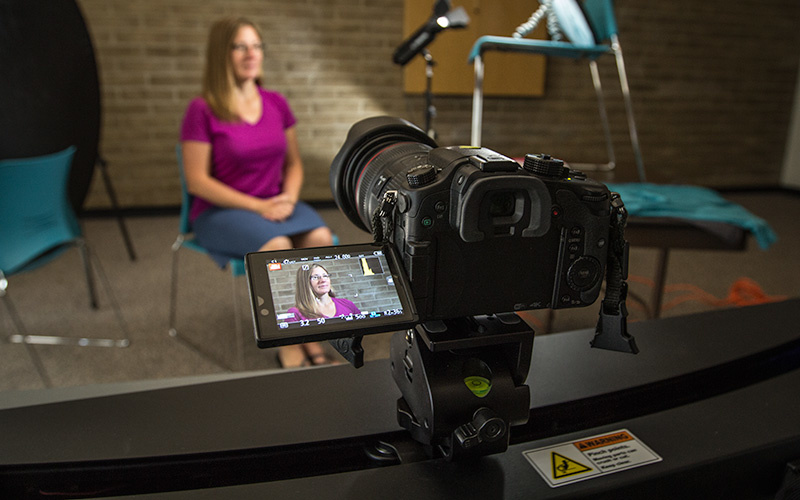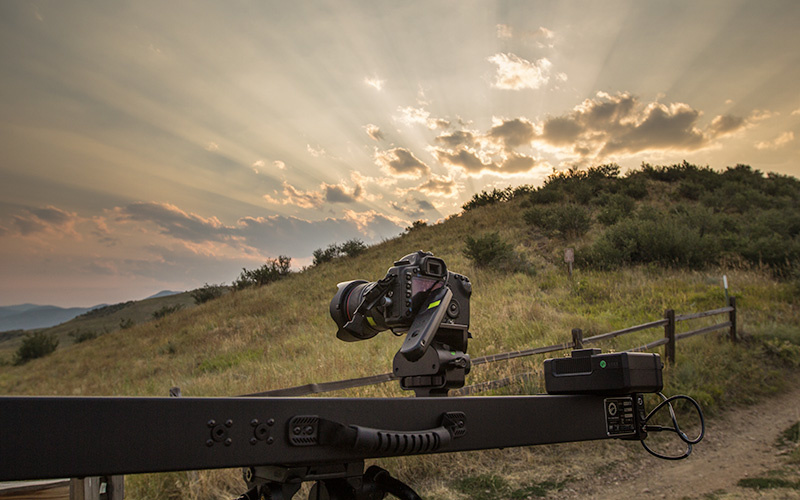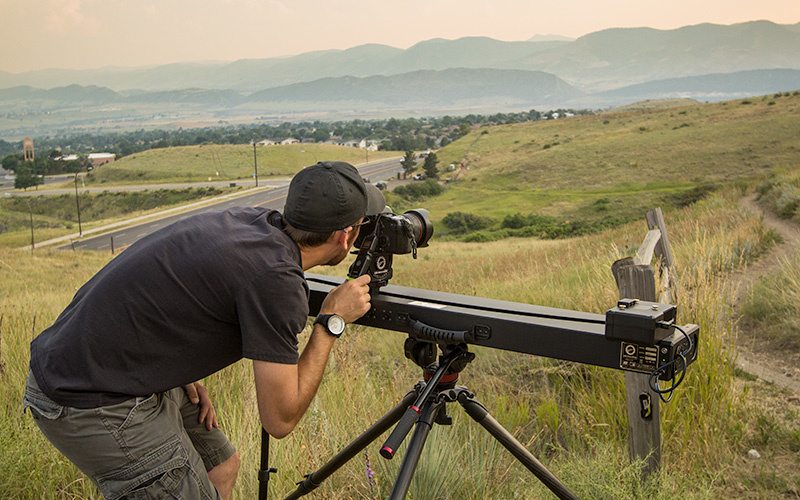I’ve been a user of the original One Man Crew for many different videos. It’s ability to get elegant motion video clips have made it a go-to piece of gear for when I need my interviews to have an interesting look to them. When I heard that an updated version was being released, I was excited to see if a few issues were fixed. In this gear review, I'll break down what is fixed, and what left me wanting more.
The One Man Crew from Red Rock Micro was one of the first automated sliders of its kind to hit the market a few years back. This self-contained, easy to use unit allowed documentary filmmakers to step out from behind the camera, and let the OMC work its magic; executing a slow moving “orbit” slide that would loop continuously. The visual interest this adds to an interview shot is unmistakable.

While you can use the One Man Crew for timelapses, there is no shoot-move-shoot mode or ability to control and sync up with your DSLR. To some, it may seem like a one-trick-pony, but it does do that trick VERY well. I’ve rented it for several corporate productions, where its only purpose was to capture slowly moving interview clips. Below is an excerpt from such a video.
I’ve even used the OMC for several projects with PRO EDU, where we used it for timelapses. Look at the last three clips in this video, starting at 1:27.
So let’s fast forward a few years to present day. A new version of the One Man Crew, called the “Director” has recently been released, but there are also a number of other affordable motion slider options available now. With a chance to review the Director, not only did I want to see how it improved upon itself, but also how it stacked up to competing units in the same price bracket.

I got my hands on one of these new units for about a week and was able to use it for both an interview shoot as well as a timelapse. What I discovered is explained alongside an analysis of its features.
What’s new in the updated “Director” Version?
To put it in two words: Not much. Granted, I didn’t have the old version next to the Director for a side-by-side comparison, but after using the original version extensively in the past, there wasn’t a whole lot that made the Director appear to be any different to me. What I did find to be different however, and more useful, were as follows:
• It’s a little bit quieter. The original OMC was next to unusable if you had sensitive mics or a quiet interview subject. I can tell that the Director is a bit quieter, but only if you’re doing slow moves. In the video below, there are four clips with the OMC Director running at different speeds, while I asked my subject to not speak. The audio you will hear is from their lapel mic, which is six feet away from the OMC.
You’ll most likely only use slower speeds for interviews, so you’re fine as long you aren’t recording audio from the camera’s built-in mic. If you do that, it's almost impossible to not hear the motor running.
• The power plug features a screw-lock to prevent accidental removal. This is actually nice to have since the old plug could easily pull out. Losing power means you have to calibrate it again, which is not only annoying, but sometimes impossible if you’re in the middle of a long interview take with the OMC running a B or C camera angle.
• Included are “cable wranglers” which do exactly that. With cords for power, monitors, mics and more, these will keep the cables from moving as much.
There’s an app for it
The most notable update isn’t physically noticeable; they have added Bluetooth to the OMC Director, which allows you to control it from your smart phone. A controller screen allows for Left-Right movement, speed changes, laser on/off, toggling record on a camera, and setting move limits.

There is also a “Gesture” mode, which allows the user to swipe and tap to control movement. This was added so that the user could control the OMC Director without looking away from an interview subject. Let’s say for example, you were shooting a one-camera interview, and you had no crew. You can press record on your camera, and then wait until your subject is about to speak, and begin the move without skipping a beat. This could be a cool feature for some folks, but didn't quite fit in with my style of conducting, shooting, and editing interviews.
I did notice that the app would sort of “take over” the OMC, and whatever speed you had set on the physical unit would be overridden by the app once it connected. It was a bonus that the app also displayed what Mode you currently were on, as you really have no way to tell otherwise.

What the app doesn’t have however, is something I feel is a huge omission. There’s no way to change the shooting mode– you still have to do it manually. The single most annoying thing about operating the OMC for me, which still exists in the Director, is that in order to change the shooting mode (changes how slow/fast it runs, or put it into Timelapse Mode) you have to turn off the unit, hold a button while powering on, set the speed to a certain number that corresponds to the mode desired, press a button, run the trolley so it calibrates (which is loud and makes a “bonk” when it hits the end of the track) and THEN you can use it. Got all that? I still mess that sequence up and like I said, I’ve used the OMC many, many times. Even when I think I’ve done everything right, I discover that it doesn’t run at the speeds expected so I must have done something wrong.

Is it Stronger?
Yes. Red Rock Micro redesigned the drive system so that it would be quieter and stronger, but I honestly can’t tell that there is much difference. Even in the specs, it says it can now hold up to 22lbs instead of the original 20lbs, so the difference is marginal.
Is it Quieter?
Yes. At slow speeds, the Director is certainly quiet enough to run during an interview. Period. You likely won’t need higher speeds for interview shots, but if you do, expect the noise to be noticeable. Not only that, but when calibrating, it’s very noisy.
Is it Smoother?
I'm not so sure. I actually noticed a bit of wiggle at the higher speeds, and when shooting with a long lens. While you wouldn't do that for an interview, it could be done for something like a product shot. Below are a few video clips that I shot specifically to check the shake. (No pro setup here, just something to see for the test.) To me it looks like there is definitely some wiggle at higher speeds, so if you’re doing a fast reveal or a quick shot of a product, you might be better off adding stabilization in post, or shooting it at a slower speed with the intention of speeding up in post. I would not recommend using IS on your lens, it will fight the slide as well as try to hold things steady, the result of which doesn't look good.
Setting it up for use
Something that bugged me with the OMC Director was how it can (or cannot) be mounted. I typically use two tripods for setting up a slider move, and when in a studio I use C-stands. The Director comes with two mount adapters for locking into light stands or C-stands, but the threads on the left and right edges are so close to the raised edges that I couldn’t screw a tripod plate onto them.

I’m working on the road right now and only had one light stand at the time of my review, so I was forced to center-mount it on my biggest tripod, and then use a light stand on just one side. Not ideal, and a simple design adjustment would allow for tripods/plates to be mounted, making this unit more versatile.
Timelapses in the field
In timelapse mode, you can run the OMC Director on a very slow move, but for long exposures you can’t set it to shoot-move-shoot, meaning you will get motion blur if your shutter is open for too long or your move is too fast.
The curved move that you get looks nice in the final result, but you don’t have any other control, so it’s kind of limited. It’s too bad there isn’t some way to lock the pan so that it becomes just a linear slide move, just for another option.
I shot a timelapse at a public park, and was able to power it from an Anton Bauer battery with a P-tap adapter.
If you look closely you can see where the unit shifted during the timelapse, which I can only assume is the result of the weight distribution changing. I could fix it in post, but to be honest if I could have mounted it with two tripods at either end, this wouldn’t have even been an issue. Additionally, I intended for this to be a ten second finished timelapse clip, not seven seconds. I set the OMC the speed setting to get around 60 minutes of travel across the curve (according to the instruction sheet) and then set my camera to a :15 interval, but the move only lasted about 40 minutes. Since I had no way to confirm exactly how fast it would move, I was at the mercy of the OMC. It's this kind of thing that makes it difficult to use for precise timelapses.

photo by Mike Kvackay - instagram.com/mkvackay
Thoughts on Price
The Director is being sold for about $2,450, while the original version was on B&H for $1,500. For the want of a slightly quieter unit, and the ability to use an app, I honestly don’t think it’s worth the extra $1,000. (If you're shopping around, know that the Kessler Second Shooter, with a 39” Stealth Slider and a 3-axis motion control kit sells for about $2,200 and might be worth a look.)
What's Awesome
• Simple way to get a great look for interview video
• Adds an element of motion to timelapse shots
• Self contained - no dangling cords except for power
• Can be run off of an Anton Bauer battery with an adapter cable
What Could Be Improved
• Add mode control to the app
• Add small number displays on the control end that tells you the mode, and time of one-way travel at current speed
• Add the ability to set the travel time, as opposed to a speed
• Add the control instructions into the app (not the quick start guide, and not just a link to a webpage, make it accessible when not connected)
• Add 1/4-20" and 5/8" threads to the underside at each end, about 4" from the edges
• How about a couple of built in bubble levels?

Conclusion
The Director does a few different things, but only one thing very well, and that is the only reason you should be interested in this product.
It seems to me that the Director is almost aiming to be more for the advanced amateur, who needs something they can simply plug in and press go. It’s self-contained, and if you’re only using it in Mode 1 (slow video interview moves) it’s extremely convenient and very fast to set up.
If you’re doing documentary or corporate interviews on the regular, this could be a great addition to your kit. I would advise that you look at all of your options before purchasing though, including considering the original version of the One Man Crew.

I guess what it boils down to for me is that when I spend a few thousand dollars on accessories for my video and photo work, I want that accessory to be as versatile and useful as possible. I don't see the One Man Crew Director as being all that versatile.
Honestly, I am a bit let down in this new version. I was hoping for a more intuitive control system for changing the modes, and new features besides a simple app. I know that this unit’s primary purpose is to shoot video interviews, but for $2,450 can’t we have a few more bells and whistles?





We absolutely love our original One Man Crew and use it all the time for interviews. It really sings outdoors where you can get the background far away from your subject an zoom in tight. I do totally agree with you about changing the modes. I don't know why they didn't just add a little dip switch somewhere. I prefer physical buttons over holding buttons and memorizing weird combinations. I remember the Kessler Crane Stealth controller was even worse with crazy button combinations.
The noise is definitely an issue with any movement past like level 4. I've even thought about building some sort of insulated case to keep the unit in to make it quieter but I guess you would always need that top to be exposed and free from obstruction. We've always had to send our audio to Audition and noise reduce the slider out of the main audio if it is too loud which isn't ideal.
All in all though I agree with you, this is sort of a one trick pony but if I had to choose a 2nd or 3rd camera for an interview I would always choose this slider for that camera angle.
Great review and I agree it doesn't seem like an upgrade worth the price. Also what lights are you using there for hte interviews?
Austin, thanks for reading the review. I was using this kit: http://www.bhphotovideo.com/c/product/1126520-REG/litepanels_909_1001_po...